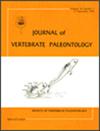A new typothoracine aetosaur (Archosauria, Pseudosuchia) from the Upper Triassic of India with insights on biostratigraphy, diversification, and paleobiogeographySUPPLEMENTARY FILES—Supplementary files are available for this article for free at www.tandfonline.com/UJVPCitation for this article: Haldar, A., Ray, S., & Bandyopadhyay, S. (2023) A new typothoracine aetosaur (Archosauria, Pseudosuchia) from the Upper Triassic of India with insights on biostratigraphy, diversification, and …
IF 1.9
4区 地球科学
Q2 PALEONTOLOGY
引用次数: 0
Abstract
ABSTRACTA new typothoracine aetosaur is described based on multiple isolated and articulated left paramedian and lateral osteoderms recovered from the Upper Triassic lower Dharmaram Formation of India. The partial carapace of the new taxon is reconstructed as strongly discoidal based on the curvature of the paramedian osteoderms with the widest one positioned dorsal to the mid-dorsal trunk vertebra. Asymmetric lateral osteoderms with acute flexion are considered as precaudals with the angle of flexion decreasing posteriorly. Phylogenetic analysis recovered the new taxon as deeply nested within the clades Typothoracinae and Paratypothoracini, and a sister taxon to Kocurypelta silvestris. The autapomorphic characters involving paramedian osteoderms dorsal to the trunk vertebrae include dorsal surface ornamented by large, irregular pits surrounding the dorsal eminence and radiating ridges in other areas, straight anterior margin of the anteromedial corner of the anterior bar in dorsal view, and raised or ridged and ornamented posteromedial corner. The current study highlights the significance of the new aetosaur, and the age of the lower Dharamaram Formation is modified here as mid-Norian to Rhaetian based on global correlation with other coeval horizons. The recovery of this taxon marks the first record of Paratypothoracini from high paleolatitudes of the Gondwanan region. The study corroborates the earlier findings of a strong Laurasian faunal influx in India during the Late Triassic suggesting possible land bridges and/or conducive environmental conditions for faunal dispersal.http://zoobank.org/urn:lsid:zoobank.org:pub:FCC37C0E-107F-4B15-9460-4E802B465865 ACKNOWLEDGMENTSThe fossil specimens were collected by T. S. Kutty, Geological Studies Unit, Indian Statistical Institute, Kolkata. We thank D. Mukherjee of the same Institute, and D. Datta, Department of Earth Sciences, Indian Institute of Technology, Roorkee for advice and help throughout the study. We thank A. Huttenlocker, T. Sulej, P. L. Godoy, and an anonymous reviewer for thorough revision and constructive suggestions. D. Pradhan and L. Mahankur are gratefully acknowledged for preparation and removal of matrices from the fossil specimens. The financial assistance was provided by Science and Engineering Research Board, India (SERB/CRG/000388) to SR. The Indian Institute of Technology Kharagpur and Indian Statistical Institute Kolkata are acknowledged for providing infrastructural facilities to AH and SR, and SB, respectively.DISCLOSURE STATEMENTNo potential conflict of interest was reported by the authors.SUPPLEMENTARY FILESSupplementary File 1.docx: Details of the characters used for the phylogenetic analysis.Supplementary File 2.nex: Combined characters and data matrix used for phylogenetic analysis.Supplementary File 3.docx: Resampled MPTs (ordered).Supplementary File 4.tre: MPTs of the parsimony analysis (unordered).Supplementary File 5.docx: List of synapomorphies.Additional informationNotes on contributorsSanghamitra RaySR conceptualized and designed the project, AH, SR collected and analyzed data, AH drafted the manuscript, SR carried out interpretative line drawings, acquired funding and administered the project. All authors edited the manuscript.Saswati BandyopadhyaySB conceptualized and designed the project, AH, SR collected and analyzed data, AH drafted the manuscript, SR carried out interpretative line drawings, acquired funding and administered the project. All authors edited the manuscript.一种来自印度上三叠世的新型胸胸主龙(Archosauria, Pseudosuchia),具有生物地层学、多样性和古生物地理学方面的见解。补充文件-本文的补充文件可在www.tandfonline.com/UJVPCitation免费获得。Bandyopadhyay, S.(2023)印度上三叠统一种新型型胸兽鼻祖龙(Archosauria, Pseudosuchia)及其生物地层学、多样性和研究进展。
基于在印度上三叠统下Dharmaram组中发现的多个分离和关节的左侧副骨皮和外侧骨皮,描述了一种新的典型胸恐龙。新分类群的部分甲壳根据旁正中骨皮的曲率重建为强烈盘状,最宽的一个位于躯干脊椎骨的中背侧。具有急性屈曲的不对称外侧骨皮被认为是前跖骨,屈曲角度向后减小。系统发育分析发现,该新分类群深嵌于胸甲亚支和副胸甲亚支中,是银尾胸甲亚支的姐妹分类群。躯干椎骨背侧旁正中骨皮的自形特征包括:背隆起周围有不规则的大凹坑,其他部位呈放射状突起;背侧观前棘前内侧角前缘直;后内侧角隆起或脊状突起。目前的研究强调了新翼龙的重要性,根据与其他同时期地层的全球对比,本文将下Dharamaram组的年龄修改为中诺里亚至雷提亚。这一分类群的发现标志着在冈瓦南地区高海拔地区首次发现了paratypothorini。该研究证实了早前的发现,即晚三叠世期间印度有大量的Laurasian动物涌入,表明可能存在陆桥和/或有利于动物分散的环境条件。http://zoobank.org/urn:lsid:zoobank.org:pub:FCC37C0E-107F-4B15-9460-4E802B465865致谢化石标本由加尔各答印度统计研究所地质研究部门的T. S. Kutty收集。我们感谢同一研究所的D. Mukherjee和印度理工学院地球科学系D. Datta在整个研究过程中提供的建议和帮助。我们感谢A. Huttenlocker, T. Sulej, P. L. Godoy和一位匿名审稿人的彻底修改和建设性的建议。D. Pradhan和L. Mahankur对从化石标本中制备和移除基质的工作表示感谢。财政援助由印度科学和工程研究委员会(塞尔维亚/CRG/000388)提供给SR.印度理工学院Kharagpur和印度统计研究所加尔各答分别为AH和SR和SB提供基础设施。声明作者未报告潜在的利益冲突。补充文件补充文件1.docx:用于系统发育分析的字符的细节。2.补充文件下:用于系统发育分析的组合性状和数据矩阵。补充文件3.docx:重新取样的mpt(订购)。补充文件4。3:简约分析的mpt(无序)。补充文件5.docx:突触形态列表。ssanghamitra RaySR对项目进行了概念化和设计,AH, SR收集和分析数据,AH起草了手稿,SR进行了解释性的线条绘制,获得了资金并管理了项目。所有作者都编辑了这份手稿。Saswati BandyopadhyaySB对项目进行了概念化和设计,AH和SR收集并分析了数据,AH起草了手稿,SR进行了解释性的线条绘制,获得了资金并管理了项目。所有作者都编辑了这份手稿。
本文章由计算机程序翻译,如有差异,请以英文原文为准。
求助全文
约1分钟内获得全文
求助全文
来源期刊
CiteScore
2.90
自引率
7.10%
发文量
58
审稿时长
4-8 weeks
期刊介绍:
The Journal of Vertebrate Paleontology publishes original contributions on all aspects of vertebrate paleobiology, including vertebrate origins, evolution, functional morphology, taxonomy, biostratigraphy, phylogenetics, paleoecology, paleobiogeography, and paleoanthropology. JVP publishes high quality peer-reviewed original articles, occasional reviews, and interdisciplinary papers. It is international in scope, and emphasizes both specimen- and field-based based research and the use of high-quality illustrations. Priority is given to articles dealing with topics of broad interest to the entire vertebrate paleontology community and to high-impact specialist studies. Articles dealing with narrower topics, including notes on taxonomic name changes (unless these deal with errors published in JVP), preliminary site reports, and documentation of new specimens of well-known taxa, are afforded lower priority.

 求助内容:
求助内容: 应助结果提醒方式:
应助结果提醒方式:


